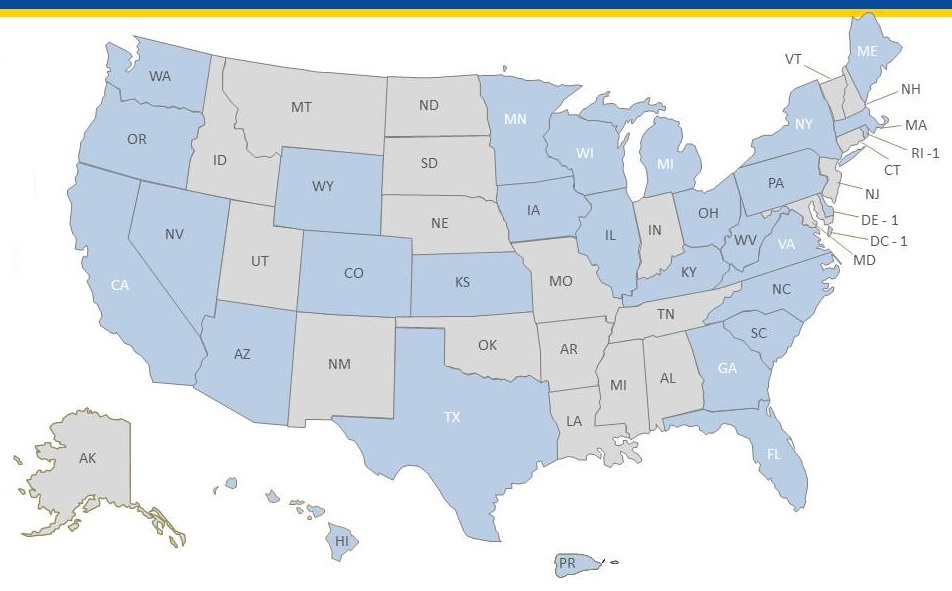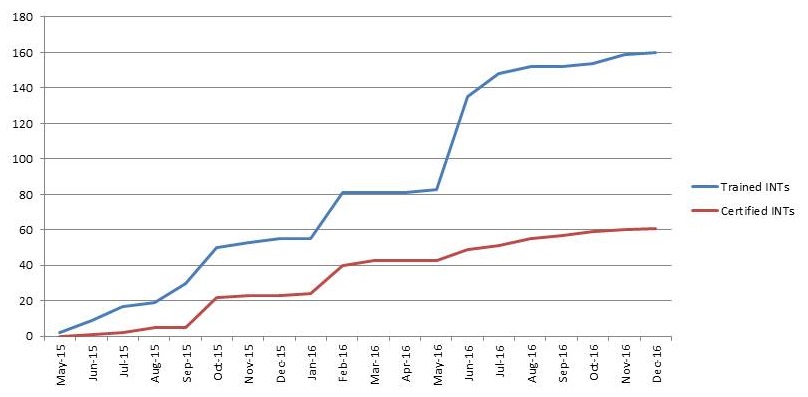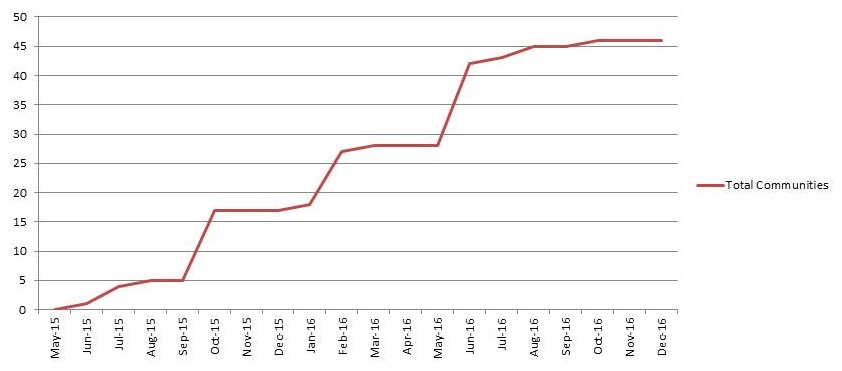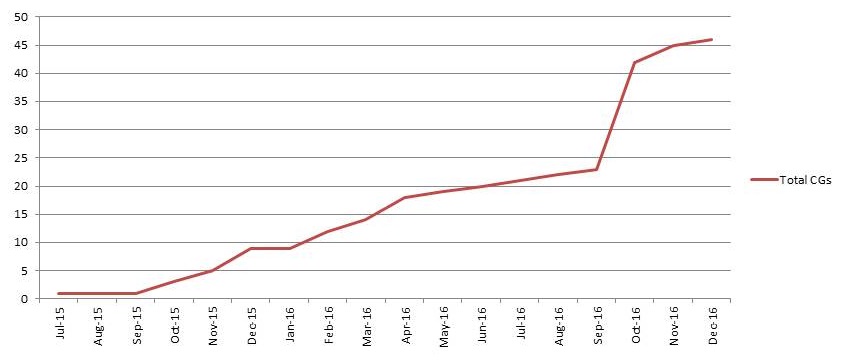Friday, February 3, 2017
Printer Friendly Version in PDF Format (7 PDF pages)
Long-Term Services and Supports Committee Update
Administration for Community Living
| ASSSP and ADI-SSS Grants |
|---|
 |
- Planning a half day intensive on entitled: Improving Care and Services for People with Dementia and their Family Caregivers for the March 2017 Aging Society of America (ASA) Conference in Chicago.
- Coordinating a special electronic Alzheimer's and Dementia edition of Generations: Journal of the American Society on Aging for publication later in 2017.
- January 17th kicked off ACL's Annual National Alzheimer's and Dementia Resource Center (NADRC) webinar series with a webinar highlighting Minnesota's Cultural Consultants initiative.
- 5th Annual Dementia Resources and Research free webinar series tentatively scheduled to begin March 1. The series promotes awareness of research participation opportunities and improving coordination of federal resources available to assist people with ADRD. Target audience is aging and disability, public health, and research professionals.
What is Brain Health?
- Upcoming:
- Hispanic launch this summer featuring PSA with Hector Elizondo and an event in Miami in 2018
- Co-creation of messaging and concepts with Ogilvy Washington and Ogilvy Peru
- Engagement:
- Facebook (more than 60,000 followers)
- Animated Videos
- "Talk to Your Doctor" [https://www.youtube.com/watch?v=jHfn9dncuEg]
- "Get Moving" (more than 400,000 views on Facebook) [https://www.youtube.com/watch?v=WrHtf8veSbs]
- Story Telling Event Series called Laugh Lines [https://www.youtube.com/watch?v=QQP834IsoMw]
- Marcia Gay Harden PSA (aired more than 1,000 times, value $11m) [https://www.youtube.com/watch?v=HvAafau0tvE]
- Awards:
- In2 SABRE 2016: Best Use of Innovative Channels- Government/Public Affairs, Finalist for Brand Digital Platforms
- THOTH Awards 2016: Research/Evaluation
- In2 SABRE 2017: Award for Content Creation for Media Sites (Paid), Finalist for Brand Animation Videos
- PRWeek 2017: Finalist for Best in Public Sector
Centers for Medicare & Medicaid Services
Medicaid Guidance on Unsafe Wandering and Exit-Seeking
- In December CMS issued Frequently Asked Questions to clarify how providers can assist beneficiaries with ADRD receiving home and community-based services (HCBS) to live self-determined lives in fully integrated community settings
- The guidance addresses person-centered planning, promising practices, staff training, and care delivery and includes many suggestions
- HCBS settings should not restrict individuals unless it is in the person-centered plan, all less restrictive interventions have been exhausted, and any restriction is regularly reassessed
- Thank you to Jane Tilly, who with others helped prepare this guidance!
(Strategy 2.D)
Information at: http://www.medicaid.gov/medicaid/hcbs/guidance/index.html
New Data on Medicaid LTSS and Home and Community-Based Services Programs
- In November CMS released the Medicaid Long-Term Services and Supports Beneficiaries 2012 report which provides updated estimates of the number of beneficiaries who receive Medicaid long-term services and supports, including institutional care and HCBS
- CMS also issued updates to two reports that describe recent HCBS "waiver" program data including numbers of recipients and other trends
(Strategy 2G)
Information at https://www.medicaid.gov/medicaid/ltss/reports-and-evaluations/index.html and https://www.medicaid.gov/medicaid/ltss/reports-and-evaluations/index.html
Guidance on Medicaid Community First Choice State Plan HCBS Option
- In December CMS issued detailed guidance to states on the implementation of the benefit package available to states to promote community integration
- The CFC option -- which states must choose- offers eligible beneficiaries the opportunity to receive personal attendant services and supports in the community
- It allows services to be available across poplations and easily standardizes eligibility, needs assessment, and care coordination
(Strategy 2.G)
Available at: https://www.medicaid.gov/federal-policy-guidance/federal-policy-guidance.html
Indian Health Service
REACH into Indian Country
| Trained & Certified Interventionists Cumulative |
|---|
 |
| Communities Reached Cumulative |
|---|
 |
| Enrolled Caregivers Cumulative |
|---|
 |
Tribal Workforce Development LTSS and Clinical Care
- Tribal LTSS conference: November 14-17
- ACL funded, IHS / CMS co-sponsored
- Highlighting and sharing Tribal LTSS
- Tribal LTSS Technical Assistance
- Dementia Core Course: November 14, 15
- Clinical Track (CME/CEU)
- Community-based Track
- Faculty from Indian Health and Banner Alzheimer's Institute
Recognition / Diagnosis / Assessment in Indian Country
- Discussion with GWEPs about coordination of Tribal / IHS / Urban training and outreach
- IHS-RITT -- VA Rural Interdisciplinary Team Training providing intensive team training to 10 IHS and Tribal rural facilities.
- Adapting model training at the facilities of the Aleutian-Pribilof Islands Associations
National Institute on Aging
A Comparison of the Prevalence of Dementia in the United States in 2000 and 2012
- Between 2000 and 2012, the prevalence of dementia among those aged 65+ significantly decreased from 11.6% to 8.8%.
- Increases in the level of education among later born cohort was associated with lowered dementia risk and improvements in treatments for cardiovascular risk factors may have also played a role.
| Education & Presence of Dementia |
|---|
 |
| Langa, et al., 2017. JAMA Intern Med. |
Tube Feeding in US Nursing Home Residents With Advanced Dementia, 2000-2014
| Table 1. Feeding Tube Insertion Rates Among US Nursing Home Residents With Advanced Dementia in 2000 to 2014 | ||
|---|---|---|
| Year | Residents With Advanced Dementia | |
| With Recent Onset of Total Dependence for Eating, No. |
With Feeding Tubes Over Subsequent 12 Months, No. (%) |
|
| 2000 | 7029 | 820 (11.7) |
| 2001 | 6738 | 774 (11.5) |
| 2002 | 6239 | 701 (11.4) |
| 2003 | 5518 | 577 (10.5) |
| 2004 | 5194 | 462 (8.9) |
| 2005 | 4628 | 398 (8.6) |
| 2006 | 4389 | 393 (9.0) |
| 2007 | 4110 | 357 (8.7) |
| 2008 | 3890 | 331 (8.5) |
| 2009 | 3842 | 297 (7.7) |
| 2010 | 3794 | 283 (7.5) |
| 2011 | 4538 | 264 (5.8) |
| 2012 | 4246 | 235 (5.5) |
| 2013 | 3685 | 207 (5.6) |
| 2014 | 3411 | 193 (5.7) |
| Significant decreases in insertion rates from 2000 - 2014 | ||
The Disproportionat Impact of Dementia on Family and Unpaid Caregiving to Older Adults
- Approximately 1/3 of caregivers who help older adults assist someone with dementia.
- Older adults with dementia receive approximately 5x more assistance with self-care compared to individuals without dementia.
- Intensity of dementia care (hrs/month) is higher in community settings than in residential care settings.
- Families bear the majority of caregiving responsibilities for adults with dementia, with highest care intensity for caregivers residing with individuals.
Kasper et al., 2015, Health Affairs
THANK YOU!
February 3, 2017 -- Advisory Council Meeting #23
The meeting was held on Friday, February 3, 2017, in Washington, DC. The theme of this Advisory Council meeting was clinical trials for Alzheimer's disease and related dementias and recruitment challenges. Additional afternoon presentations included updates on progress towards a Care and Services Summit, federal workgroup updates, and preparation for the Advisory Council's 2017 Recommendations, due in April 2017. Material available from this meeting is listed below and is also available at https://aspe.hhs.gov/advisory-council-alzheimers-research-care-and-services-meetings#Feb2017.
Comments and questions, or alerts to broken links, should be sent to napa@hhs.gov.
General Information
-
Agenda -- [HTML Version] [PDF Version]
-
Meeting Announcement -- [HTML Version] [PDF Version]
-
Meeting Summary -- [HTML Version] [PDF Version]
-
Public Comments -- [HTML Version]
Handouts
-
Panelist Bios -- [HTML Version] [PDF Version]
Presentation Slides
-
2017 Recommendations -- [HTML Version] [PDF Version]
-
Alzheimer's Association TrialMatch -- [HTML Version] [PDF Version]
-
Clinical Services Subcommittee Federal Update -- [HTML Version] [PDF Version]
-
Clinical Studies Recruitment Strategy -- [HTML Version] [PDF Version]
-
Development and Use of Registries to Accelerate Enrollment into Alzhiemer's Trials -- [HTML Version] [PDF Version]
-
Long-Term Services and Supports Committee Update -- [HTML Version] [PDF Version]
-
National Recruitment Strategy -- [HTML Version] [PDF Version]
-
NINDS Update -- [HTML Version] [PDF Version]
-
Randomized Controlled Trials for Alzheimer's Disease -- [HTML Version] [PDF Version]
-
Strategies to Facilitate Recruitment and Screening for Alzheimer's Clinical Trials -- [HTML Version] [PDF Version]
-
Transforming AD Therapy Development -- [HTML Version] [PDF Version]
-
Update National Research Summit on Care, Services and Supports for Persons with Dementia and Their Caregivers -- [HTML Version] [PDF Version]
